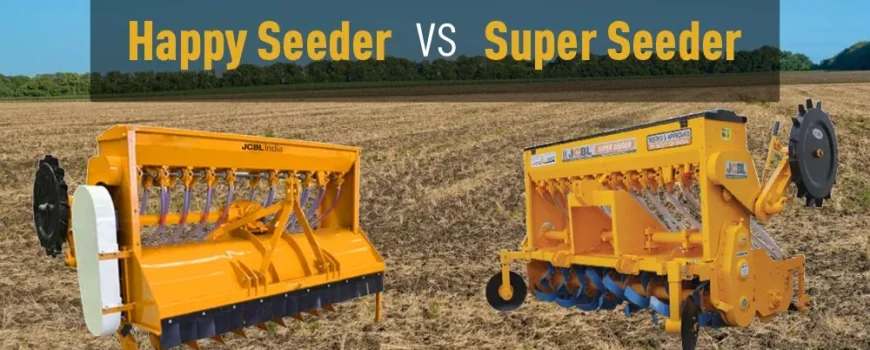The traditional method of paddy cultivation produces huge amounts of stubble which is either burnt by farmers causing pollution or incorporated back into the soil affecting the next crop yields. Both Super Seeder and Happy Seeder offer solutions to manage crop residue sustainably while improving farm efficiency and profitability. But which one of these seeders is truly better for farmers? Let’s compare the two technologies under key parameters: this blog delves into the heart of the Super Seeder vs. Happy Seeder duel, equipping you with the knowledge to conquer your toughest sowing decisions.
Finding the Right Seeder Warrior for Your Field
For Indian farmers, the age-old battle against stubble burning has fueled the rise of two agricultural titans: the Super Seeder and the Happy Seeder. Both machines stand tall, promising a solution to the burning dilemma while ushering in an era of efficient wheat sowing. But with each champion wielding unique weapons, choosing the right warrior for your field can be a daunting task. Let’s understand
The Stubble Showdown
The primary purpose of both these seeders lies in tackling the menace of stubble burning. Both utilize a direct seeding approach, minimizing soil disturbance and allowing stubble to decompose naturally. While both achieve this core objective, subtle differences emerge.
The Super Seeder’s aggressive tilling blades pulverize paddy straw, leading to faster decomposition and potentially releasing valuable nutrients quicker. However, concerns regarding soil erosion and organic matter depletion have been raised.
The Happy Seeder, on the other hand, gently cuts and spreads the straw, leaving a protective mulch layer that aids moisture retention and weed suppression. While decomposition might be slower, the concern for soil health is minimized.
The Seeding Symphony
Both seeders boast impressive sowing capabilities, ensuring uniform seed placement and depth.
The Super Seeder utilizes specialized furrow openers, ideal for heavier soils and residue management. Its seed metering mechanism allows for precise planting, especially for larger seeds like maize.
The Happy Seeder shines in lighter soils and minimal stubble conditions. Its colters cut through thin residue more efficiently, while its seed placement system excels with smaller seeds like wheat. Ultimately, the “best symphony” depends on your soil type, residue conditions, and crop choice.
Also Read: Agricultural Machinery and Technology Used in Agriculture
Affordability & Ease of Operations
Cost and ease of operation are crucial battlegrounds for any farm machinery. The Super Seeder, with its complex tilling mechanism and higher horsepower requirement, carries a heavier price tag and demands greater fuel consumption. Maintenance needs are also slightly higher.
The Happy Seeder, with its simpler design and lower power demands, proves more pocket-friendly and fuel-efficient. Its maintenance requirements are also lower, making it attractive for smaller farms.
However, the Super Seeder’s ability to handle heavier residue and work in diverse soil conditions might justify its higher cost for larger farms.
The Harvest Harmony
Both seeders aim to improve sowing efficiency, but their impact on the entire harvest cycle deserves consideration.
The Super Seeder’s thorough stubble pulverization potentially enhances wheat grain yield and quality. However, concerns remain regarding its long-term impact on soil health and sustainability.
The Happy Seeder’s mulch layer promotes soil health and moisture retention, potentially improving overall crop yields in the long run. Additionally, its gentle operation minimizes soil compaction, ensuring continued productivity in future seasons.
Victory Lap: Choosing Your Champion
Choosing between the Super Seeder and the Happy Seeder is not about declaring a single victor. It’s about selecting the warrior best suited to your specific battlefield.
Consider your soil type, residue conditions, crop choice, budget, and long-term vision for your farm. If immediate crop yields and residue management are top priorities, the Super Seeder might be your champion.
If long-term soil health, sustainability, and cost-effectiveness are your guiding principles, the Happy Seeder might be your ideal partner.
Remember, both warriors hold tremendous potential to revolutionize Indian agriculture. Choose wisely, for your decision will not only affect your harvest but also shape the future of our fertile lands.
Beyond the Duel: A United Front Towards Agriculture with JCBL
While the Super Seeder and Happy Seeder stand as individual entities, their true power lies in their collective impact. As more farmers embrace these technologies, the widespread adoption of direct seeding can revolutionize the agricultural landscape. Reduced air pollution, improved soil health, and sustainable farming practices pave the way for a brighter future for generations of farmers and consumers alike.
So, let us move beyond the duel with JCBL Agri, a renowned manufacturer and supplier of Agriculture parts including Super Seeder and Happy Seeder, and celebrate the united front these warriors present, for their seeds of progress hold the promise of a bountiful and sustainable tomorrow.
Final Thought
In the dynamic landscape of modern agriculture, choosing between the Super Seeder and Happy Seeder is a decision that hinges on various factors. Each technology brings unique benefits, from precision seeding to environmental conservation. As JCBL navigates the future of farming, the synergy of these innovations promises to shape a more sustainable and productive agricultural sector.

